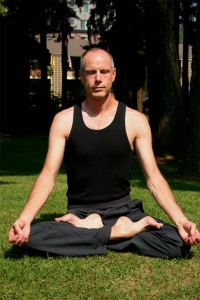 Stress is so prevalent in our culture that being stressed out is considered a ‘normal’ state of being. If you’re racing from appointment to appointment, working, worrying and losing sleep at night, you’re just one of the many that do the same thing day in and day out.
Stress is so prevalent in our culture that being stressed out is considered a ‘normal’ state of being. If you’re racing from appointment to appointment, working, worrying and losing sleep at night, you’re just one of the many that do the same thing day in and day out.
The Yin for this Yang is meditation. Meditation is the conscious act of stilling the body, mind and soul. Spending just a few minutes meditating can transform how you feel when dealing with modern life. It is the counter balance for activity.
In order to optimize your sit, you should consider the following:
The body must be relaxed
This implies that your spine is perpendicular to the floor and the muscles that hold the spine are relaxed. This is probably the biggest issue that anyone new to sitting has to deal with. To help reduce the workload, it’s critically important to have the pelvis at the same level or higher than the knees. Sit for meditation and feel the muscles around the pelvis, if they are working, sit on a pillow and notice the difference. Sitting cross-legged will always activate the lifters that connect the pelvis to the thighs inhibiting the body’s ability to relax.
The abdomen and ribs must be able to relax
When the breathing slows, or almost stops, the body will tend to tighten up. Thus, the body must be trained to breathe deeply into the abdomen, yet still have a little lift in the ribs. The training process should involve consciously releasing around the breath – or softening to allow a richer flow of air into and out of the body. Slow steady breathing will deepen the relaxation and simultaneously balance the spine.
The Head must be balanced
Most people experience tension through the back of the neck and shoulders when first learning to sit. This is caused by two things: lack of breathing and the head not being balanced on the spine. You may have the strongest neck muscles in the world, but if the head is not balanced, the muscles will never be able to relax. The work to balance is to consciously allow the center of gravity of the head drift backwards so that there is no tilt forward in the neck. As easy as this sounds, it takes practice.
When these three activities all align, your body will be receptive to the energies that surround you; energies of your own creation and energies present in your environment. This is where you get to experience the power of meditation. You’ll know you’re there when you are able to feel subtle emotions and thoughts. Meditation enhances your ability to feel.
Will Johnson, the author of The Posture of Meditation: A Practical Manual for Mediators of all Traditions seems to sum up these three principles nicely. “By locking our body into patterns of tension and rigidity, we become numb to our sensations and feelings.”
Stressful conditions force the body to be rigid.
Meditation is built upon the act of softening the body, mind and spirit. Stress and mediation, together, create conditions that allow one to bring balance into one’s life.
The yoga part is the practice.
Join David for “Yoga with Friends.” ZenRock Fitness, Sunday mornings at 9:30 am.

Leave a Reply